Brief

Mergers and acquisitions are about to undergo a renaissance.
Deal making has always been cyclical, and the last few years have felt like another low point in the cycle. But the historical success of M&A as a growth strategy comes into sharp relief when you look at the data. Bain & Company’s analysis strongly suggests that executives will need to focus even more on inorganic growth to meet the expectations of their investors.
The first installment of a three-part series on the coming M&A renaissance, "The surprising lessons of the 2000s," looks back at the last 11 years of deal activity and finds that it was a very good time for deal makers who followed a repeatable model for acquisitions. The accepted wisdom paints the decade as a period of irrational excess ending in a big crash. Yet companies that were disciplined acquirers came out the biggest winners. Another surprise: materiality matters. We found the best returns among those companies that invested a significant portion of their market cap in inorganic growth.
The second part of the series looks forward and argues that the confluence of strong corporate balance sheets, a bountiful capital environment, low interest rates and eight great macro trends will combine to make M&A a powerful vehicle for achieving a company’s strategic imperatives. The fuel—abundant capital—will be there to support M&A, and the pressure on executives to find growth will only increase as investors constantly search for higher returns. Some business leaders argue that organic growth is always better than buying growth, but the track record of the 2000s should make executives question this conventional view.
The final part of the series highlights the importance of discipline in a favorable environment for M&A. Deal making is not for everyone. If your core business is weak, the odds that a deal will save your company are slim. But if you have a robust core business, you may be well positioned. All successful M&A starts with great corporate strategy, and M&A is often a means to realize that strategy. Under pressure to grow, many companies will find inorganic growth faster, safer and more reliable than organic investments.
As M&A comes back, some executives will no doubt sit on the sidelines thinking it is safer not to play. Experience suggests that their performance will suffer accordingly. The winners will be those who get in the game—and learn how to play it well.
April 2007 was a remarkable high-water mark for M&A. That month, companies around the world announced deals worth more than half a trillion dollars in total value—the highest ever. For the year, worldwide deals would surpass 40,000 for the first time; their cumulative value would hit $4.6 trillion, 40% above the dotcom peak in 2000. It seemed like the M&A party might never stop.
But when the fiscal crisis brought the boom to an abrupt end, the hangover set in. Many business leaders again grew leery of any kind of deal making. M&A was too risky, they felt. It destroyed more value than it created. Some agreed with the often-quoted 2004 pronouncement of a CEO named Ellis Baxter, who responded to a Harvard Business School article questioning the wisdom of acquisitions. "In the end," wrote Baxter, "M&A is a flawed process, invented by brokers, lawyers and super-sized, ego-based CEOs."
The reaction was understandable. But a sober assessment of M&A activity over the past decade puts deal making in a different light. Companies that were active in M&A, the data shows, consistently outperformed those that stayed away from deals. Companies that did the most deals, and whose cumulative deal making accounted for a larger fraction of their market capitalization, turned in the best performance of all.
M&A, in short, was an essential part of successful strategies for profitable growth. Many management teams that avoided deals paid a price for their reticence.
Consider the data. From 2000 through 2010, total shareholder return (TSR) averaged 4.5% per year for a large sample of publicly traded companies around the world. Dividing this sample according to companies’ M&A activity, here’s what we observe:
- Players outperformed bystanders. As a group, companies that engaged in any M&A activity averaged 4.8% annual TSR, compared with 3.3% for those that were inactive.
- Materiality mattered—a lot. Companies that did a lot of deals outperformed the average most often when the cumulative value of their acquisitions over the 11-year period amounted to a large percentage of their market capitalization.
- The gold standard of M&A is a repeatable model. Companies that built their growth on M&A—those that acquired frequently and at a material level—recorded TSR nearly two percentage points higher than the average.
The research supporting these numbers is robust, and it points the way to a powerful tool for growth. If your company has a successful strategy, you can use the balance sheet to strengthen and extend that strategy. M&A can help you enter new markets and product lines, find new customers and develop new capabilities. They can help you boost your earnings and turbocharge your growth.
The trick, as always, is to do M&A right.
Which deal makers succeed?
M&A can be a slippery subject to study. Businesspeople, trained in the case method, often try to draw lessons from individual examples. M&A fans point to successes such as Anheuser-Busch InBev, whose mergers and acquisitions have made it the world’s largest brewer. Skeptics point to classic deal-making busts such as AOL-Time Warner. The trouble is, you can find a story to fit virtually any hypothesis about M&A, including the argument that a company can prosper without relying on deals (look at IKEA or Hankook Tire). Case-study evidence is always helpful in understanding M&A specifics, but as a guide to the territory it can be misleading.
To establish a foundation on the overall results of deal making, we launched a worldwide research project involving more than 1,600 publicly traded companies and covering more than 18,000 deals from 2000 through 2010. We assessed the performance of companies that engaged in M&A and those that did not. We compared results for companies that did a lot of acquisitions with those that did relatively few. We also looked at whether the cumulative size of deals relative to a company’s market capitalization made a difference. (For more on the research, see below, "What we studied and how we gauged performance.")
Data from this study shows unequivocally that deal making paid off during that 11-year period. Companies that were actively engaged in M&A outperformed inactive companies not only in TSR but in sales growth and profit growth as well. The data also underscored the fact that the world of M&A is not uniform and shouldn’t be treated as such. Some companies were able to use deals to power consistently higher performance. Others were far less successful, and often pursued deals that failed to pay off.
Every transaction has its own characteristics. In general, however, the difference boiled down to two main factors:
Frequency. As a rule, the more experience a company has doing M&A, the greater the likelihood that its deals will be successful. Companies in our study that were inactive—no mergers or acquisitions during the period—recorded 3.3% annual TSR (see Figure 1). Those that did between one and six acquisitions boosted their performance significantly, to 4.5%, and those that did more than six topped 5% TSR. These seemingly modest differences in annual TSR add up to significant disparities over a decade. The top group, for example, had 21% higher returns than the inactive group.
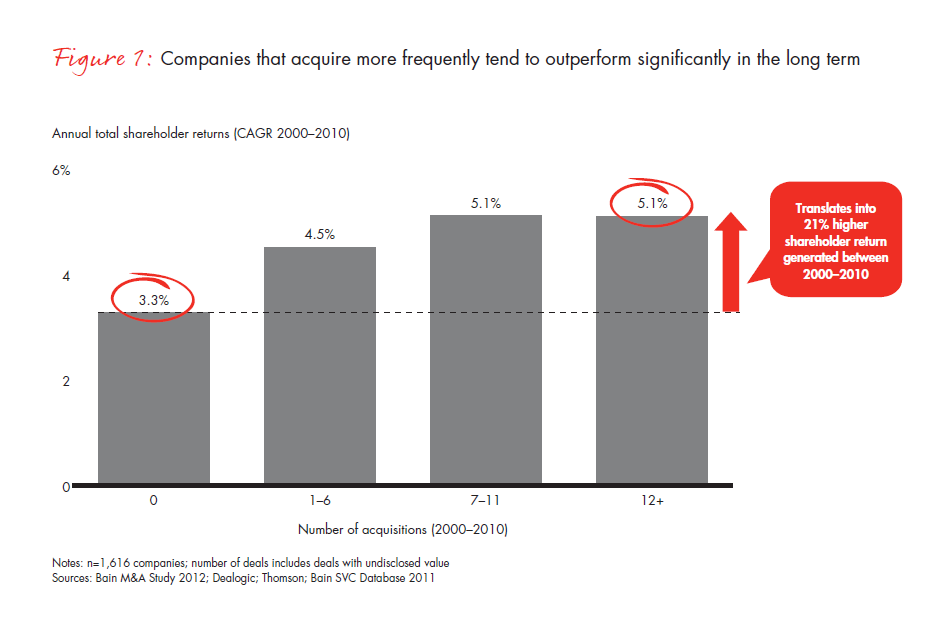
The difference between frequent acquirers and occasional ones is hardly a mystery. Experience counts. A company that does more acquisitions is likely to identify the right targets more often. It is likely to be sharper in conducting the due diligence required to vet the deals. It is also likely to be more effective at integrating the acquired company and realizing potential synergies. Stanley Works, for example—now Stanley Black & Decker (SB&D)—embarked on an aggressive M&A program beginning in 2002, and over the next several years it acquired more than 25 companies. It used operational capabilities such as the Stanley Fulfillment System to improve the acquired businesses, and it grew more and more successful at realizing synergies through post-merger integration. After acquiring key competitor Black & Decker in 2010, more than doubling its size, it was able to exceed its original savings estimates for the deal by more than 40%. From 2000 through 2010, SB&D recorded annual TSR of 10.3%.
Materiality. Previous studies, including our own, have noted the importance of frequency in determining a company’s likely return from M&A. Our research highlights the importance of another variable: the cumulative size of a company’s deals relative to its value. The more of a company’s market cap that comes from its acquisitions, the better its performance is likely to be. In fact, companies making acquisitions totaling more than 75% of their market cap outperformed the inactives by 2.3 percentage points a year, and they outperformed the more modest acquirers by one percentage point a year (see Figure 2).
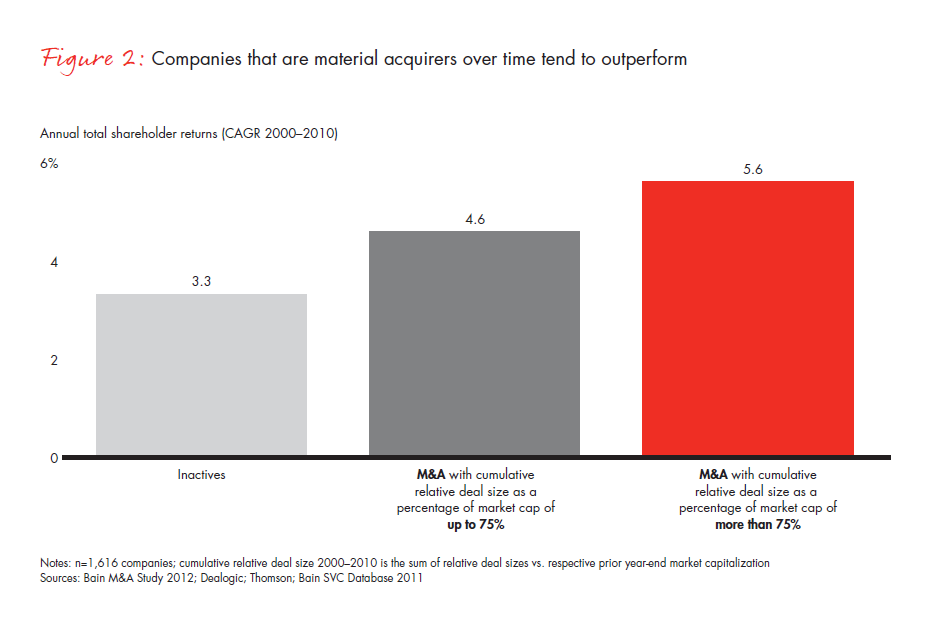
It can be difficult to untangle cause and effect when studying M&A. Companies whose acquisitions add up to a large fraction of their market cap may be successful because they can find the right deals to do, or it may be that already successful companies are in a better position to do deals. But the implications are clear regardless. A company with a strong business is likely to boost its performance by consistently pursuing M&A, to the point where its deals account for a large fraction of its value. If a company’s business is weak, however, it is highly unlikely that one big deal will turn it around.
Put frequency and materiality together and you get a clear picture showing which companies have been most successful at M&A (see Figure 3). Viewing M&A through this lens also reveals what kind of deal making produces the greatest rewards.
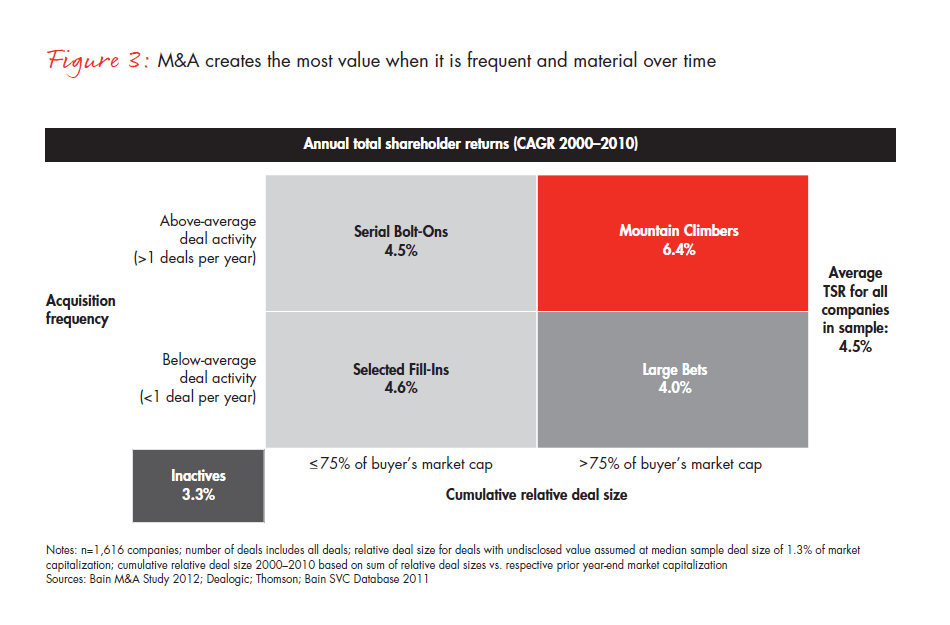
The first takeaway: The average annual TSR for all 1,600-plus companies that we studied was 4.5%.
Two groups fell below this average. One was the bystanders or inactives, the companies that sat on the M&A sidelines. Some companies in this group, of course, were committed to organic growth and performed well despite a lack of M&A: Hankook’s TSR was a remarkable 26.3%. But many others may have been too weak or too reticent to get in the game, and their performance suffered accordingly. Interestingly, even companies that avoid M&A during periods of rapid expansion may find themselves turning to deal making as organic growth possibilities cool off. By 2012, for instance, Hankook was scouting for deals in the automotive parts market.
The other below-average group appears in the box labeled Large Bets. These companies made relatively few acquisitions, averaging less than one a year, but the total value of the deals still accounted for more than 75% of their market cap. In other words, they were swinging for the fences, hoping to improve their business with a couple of big hits. Such deals are the riskiest of all. Though they sometimes work, big bets as a strategy usually fail to pay off. Tata Motors has been successful so far in its acquisition of Jaguar and Land Rover—a remarkably ambitious large bet that contributed to Tata’s TSR of 18.4% between 2000 and 2010. More common, however, are unsuccessful big bets, such as the bid by YRC Worldwide Inc. to assemble a major transportation and freight handling company with acquisitions of Roadway Corp. in 2003 and USF Corp. in 2005. YRC's total shareholder return over the decade was negative 35% and the company avoided bankruptcy in late 2009 only through a complex bond-swap agreement with creditors.
Two other groups of companies engaged in a modest level of M&A, not a material amount. We have labeled these companies "Serial Bolt-Ons" and "Selected Fill- Ins" depending on the frequency of their deals, but the results for both groups were much the same: about average. These companies’ deals, however numerous, were simply too small in the aggregate to move the needle on performance. Here, too, however, there is variation. Apple—usually held up as a model of organic growth—has in fact acquired a series of small companies, adding critical skills and capabilities (such as voice recognition) that it otherwise lacked. Amazon has added new product categories through the acquisition of Zappos, Diapers.com and others; it has also added back-office capabilities, such as the warehouse robotics provided by its purchase of Kiva Systems. But for every Apple or Amazon there are many companies whose M&A strategy simply didn’t add much. Unless the experience ultimately leads to larger deals, these companies were very likely squandering resources on deals that made little or no difference to their financial results.
The only companies with deal-making returns significantly above average are the "Mountain Climbers." These companies are the M&A stars, with returns almost two percentage points above the average and more than three points above the inactives. They acquire frequently. Their acquisitions add up in terms of materiality. Their deals are generally well conceived, reinforcing their strategy. They develop strong capabilities, both for executing deals and for post-merger integration, and they can use these capabilities effectively in pursuing large, complex transactions.
Look, for instance, at companies such as Schneider Electric (based in France), Wesfarmers (Australia) or Precision Castparts (US). All have used serial acquisitions effectively to expand into new geographies, new markets or both, thus boosting their growth. Such companies often hone their acquisition skills on smaller deals, enabling them to move quickly to acquire a larger target when the time is right. Wesfarmers, for example, did about 20 deals in the decade prior to its 2007 acquisition of Coles Group, the large Australian retailer (which more than doubled its market cap). Wesfarmers’ TSR averaged 13.4% a year from 2000 through 2010.
Developing a repeatable model
Most successful companies develop a repeatable model—a unique, focused set of skills and capabilities that they can apply to new products and new markets over and over. As our colleagues Chris Zook and James Allen show in their 2012 book, Repeatability, repeatable models are key to generating sustained growth. Our own analysis and experience confirm the power of repeatability in the world of M&A. An acquirer’s expertise in finding, analyzing and executing the transaction, and then in integrating the two companies when the deal is done, determines the success of the typical deal. Frequent acquirers create a repeatable M&A model, one that they return to again and again to launch and negotiate a successful deal (see Figure 4). Look, for example, at Anheuser-Busch InBev, which has built its remarkable growth on a foundation of successful mergers and acquisitions. Each major deal has allowed the company not only to expand but to increase its EBITDA margin, using well-honed skills both in integrating the merger parties and boosting productivity throughout the new organization.
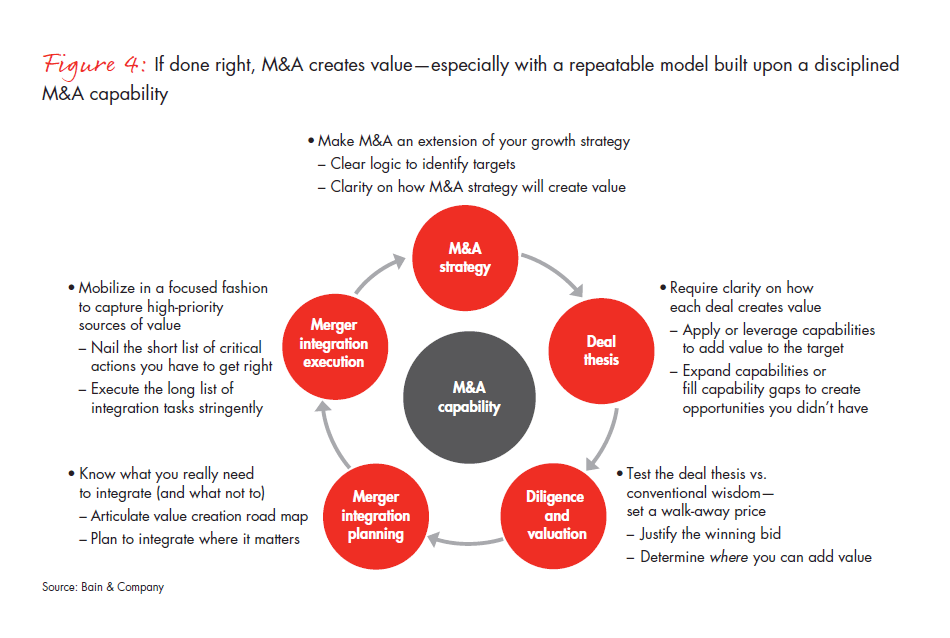
Understanding the elements of this repeatable model in detail shows the variety of skills that frequent acquirers develop.
First, successful acquirers understand their strategy and create an M&A plan that reinforces the strategy. The strategy provides a logic for identifying target companies.
Second, they develop a deal thesis based on that strategy for every transaction. The thesis spells out how the deal will add value both to the target and to the acquiring company. For example, it may expand the acquirer’s capabilities, create new opportunities for existing capabilities, generate significant cost synergies or give the acquirer access to new markets. Early development of a meaningful deal thesis derived from a company’s strategy pays off. In earlier interviews with 250 executives around the world, we found that 90% of successful deals started with such a thesis, compared with only 50% of failed deals.
Third, they conduct thorough, data-based due diligence to test their deal thesis, including a hard-nosed look at the price of the business they are considering. There will always be a conventional-wisdom price for a target company, usually an average of whatever industry experts and Wall Street analysts think it is worth. A frequent acquirer knows exactly where it can add value and is therefore able to set its own price—and to walk away if the price isn't right. Inadequate diligence is high on the list of reasons for disappointing deal outcomes. In a 2012 survey of more than 350 executives, the top two reasons for perceived deal failure were, first, that due diligence failed to highlight critical issues (59% of respondents) and, second, that the company had overestimated potential synergies in the deal (55% of respondents).
Fourth, successful acquirers plan carefully for merger integration. They determine what must be integrated and what can be kept separate, based on where they expect value to be created. This is one area that we observe has improved measurably during the past decade: Companies are devoting far more time, attention and resources to integration. In 2002, executives we surveyed said the No. 1 reason for disappointing deal results was because they "ignored potential integration challenges." In 2012, integration challenges had dropped to No. 6 among the causes cited by executives for disappointing deal results.
Finally, they mobilize to capture value, quickly nailing the short list of must-get-right actions and effectively executing the much longer list of broader integration tasks.
Developing a repeatable model gives frequent acquirers advantages that opportunistic acquirers lack. Look, for example, at the difference between Mountain Climbers and the Large Bettors. Both were engaged in substantial acquisitions, yet Mountain Climbers enjoyed a significantly greater return, on average, than their opportunistic counterparts. One reason may be that the Large Bettors tended to stick to scale deals, staying in the same business but increasing their scale of operations; more than three-quarters of the group’s transactions fell into this category. Scale deals are presumably safer, promising measurable cost synergies, but they rarely provide any top-line growth and may require flawless integration to capture the potential value. Meanwhile, the Mountain Climbers were able to execute scope deals, which accounted for nearly half of their transactions in our study. These deals expanded the range of the Mountain Climbers’ business and helped boost their performance.
The pressure to grow is only going to increase with time. Looking back at the first decade of this century, it is clear that many companies succeeded in delivering superior shareholder returns using M&A as a weapon for competitive advantage. Executives had to be smart about it, and they had to be committed. But for those with a repeatable model, the rewards were exceptional. Over the next several years we believe the environment will become increasingly conducive to well-conceived deal making. In the second part of this series, we will look at how the market environment, company balance sheets and the emerging need to find new capabilities to expand the scope of competition will all feed the M&A cycle. In that environment, inorganic growth is likely to be a key to unlocking strategic imperatives for many, many companies. Then, in the third part, we will examine in detail how individual companies capitalize on such an environment by creating repeatable models, thereby increasing their odds of deal-making success. Not every company can do it. But the rewards are substantial for those that can.
David Harding is a partner with Bain & Company in Boston and co-leader of Bain’s Global M&A practice. Satish Shankar is a Bain partner in Singapore and leader of the firm’s Asia-Pacific M&A practice. Richard Jackson is a partner in London and leader of Bain’s M&A practice in EMEA.
What we studied and how we gauged performance
Bain has been studying M&A for more than 10 years. In 2011 and 2012, we conducted a large-scale quantitative study of company performance as it related to M&A. We also surveyed more than 350 executives around the globe (in partnership with the Economist Intelligence Unit) about their views of M&A.
The quantitative research reviewed the financial performance and M&A activity of 1,616 publicly listed manufacturing and service companies from 2000 through 2010. The sample initially included all companies from 13 developed and emerging countries for which we were able to obtain full financial data; these countries account for nearly 90% of world GDP attributable to the top 20 economies. We then excluded companies with revenues of less than $500 million in 2000, those with major swings in earnings before interest and taxes (EBIT) margin around 2000 or 2010, and natural resource and financial companies, which exhibit different industry dynamics. We also examined the effect of "survivorship bias"—the exclusion of companies that had ceased to exist during this period—and found that whatever bias may exist did not affect our performance benchmarks.
To compare company performance, we used total shareholder return (TSR), defined as stock price changes assuming reinvestment of cash dividends. We calculated average annual TSR using annual total investor return (TIR) provided by Thomson Worldscope for year-ends 1999 to 2010. We analyzed M&A activity by including all acquisitions—more than 18,000 in all—announced by the companies in the sample between the beginning of 2000 and the end of 2010. The data was based on information provided by Dealogic and included all deals in which a company had made an outright purchase, an acquisition of assets or acquisition of a majority interest. For deals with an undisclosed deal value, we assumed a deal size of 1.3% of the acquirer’s market capitalization, the median value.
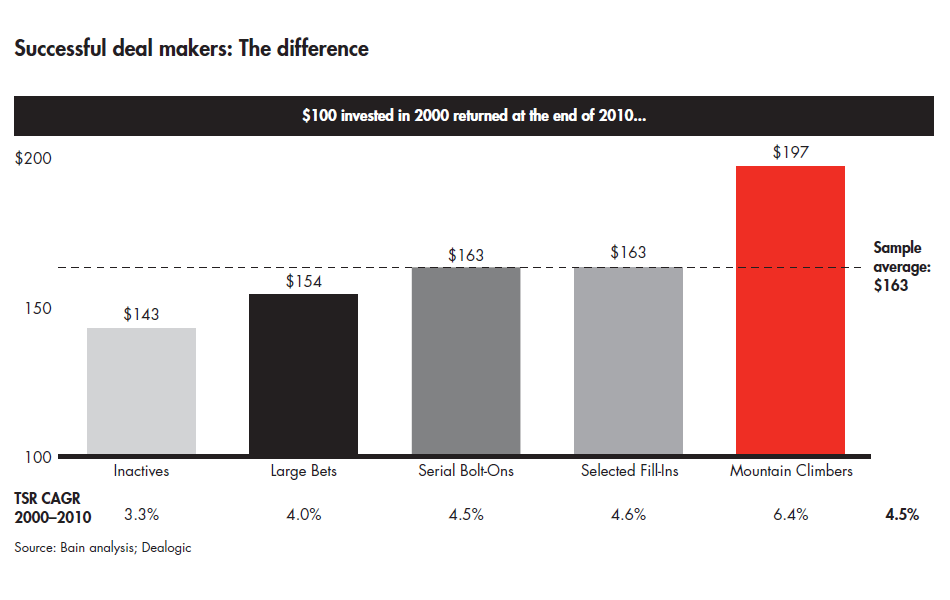





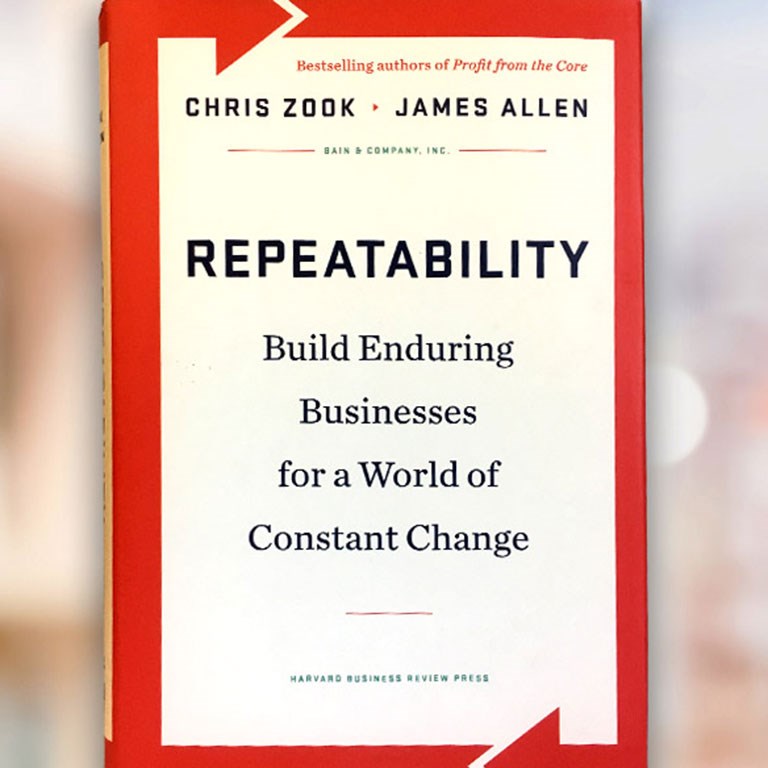
Repeatability
Learn more about how executives use Repeatable Models® to build enduring businesses.